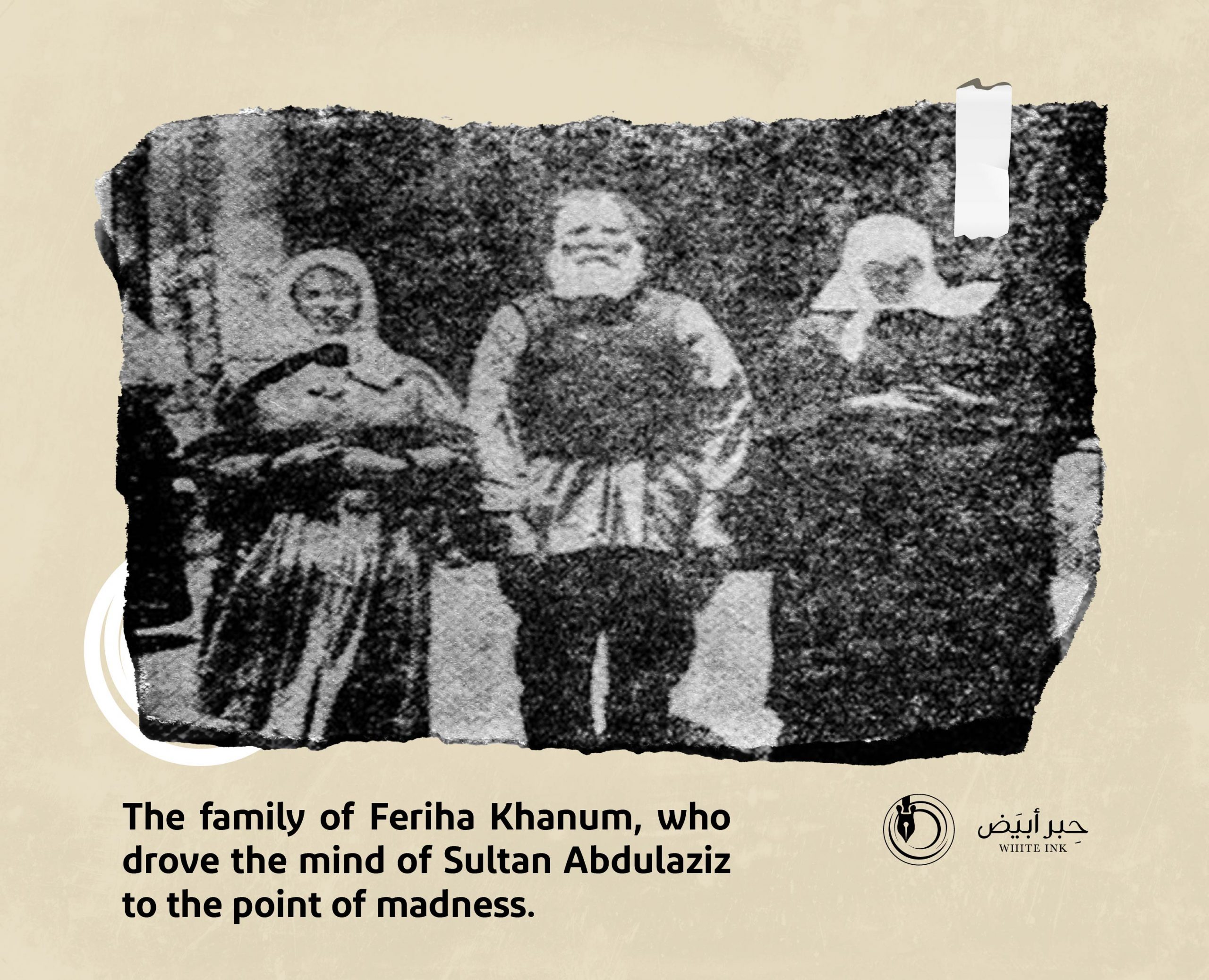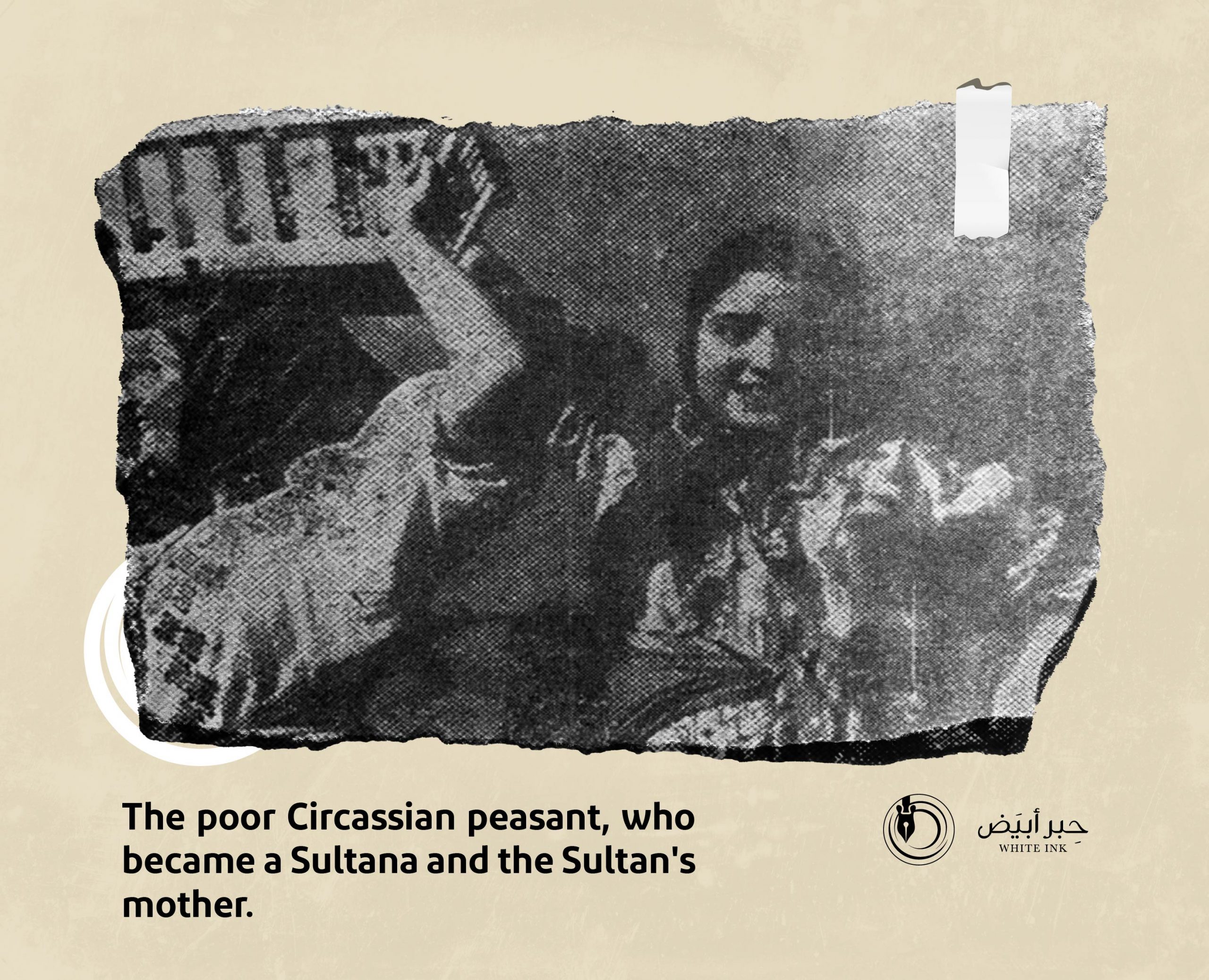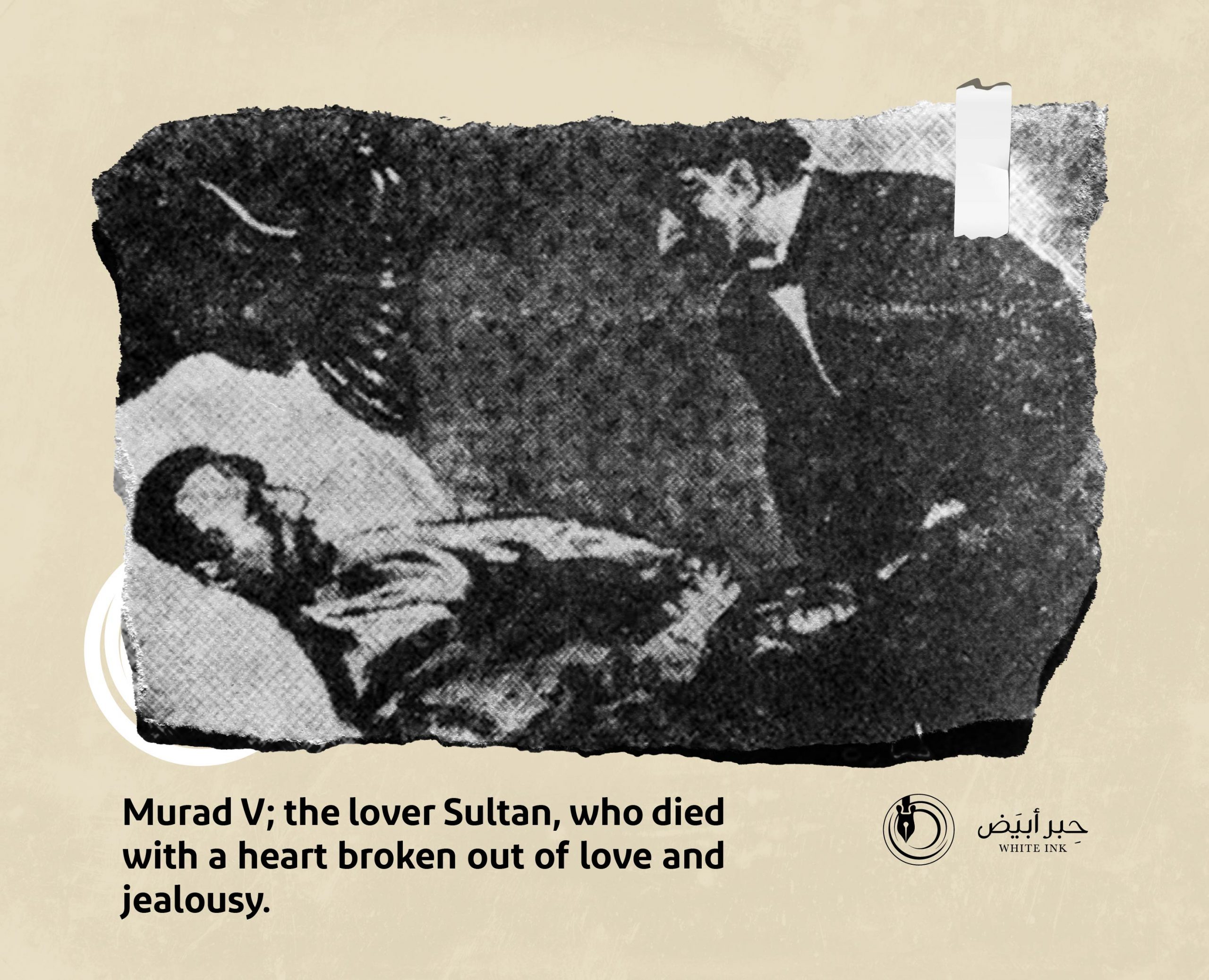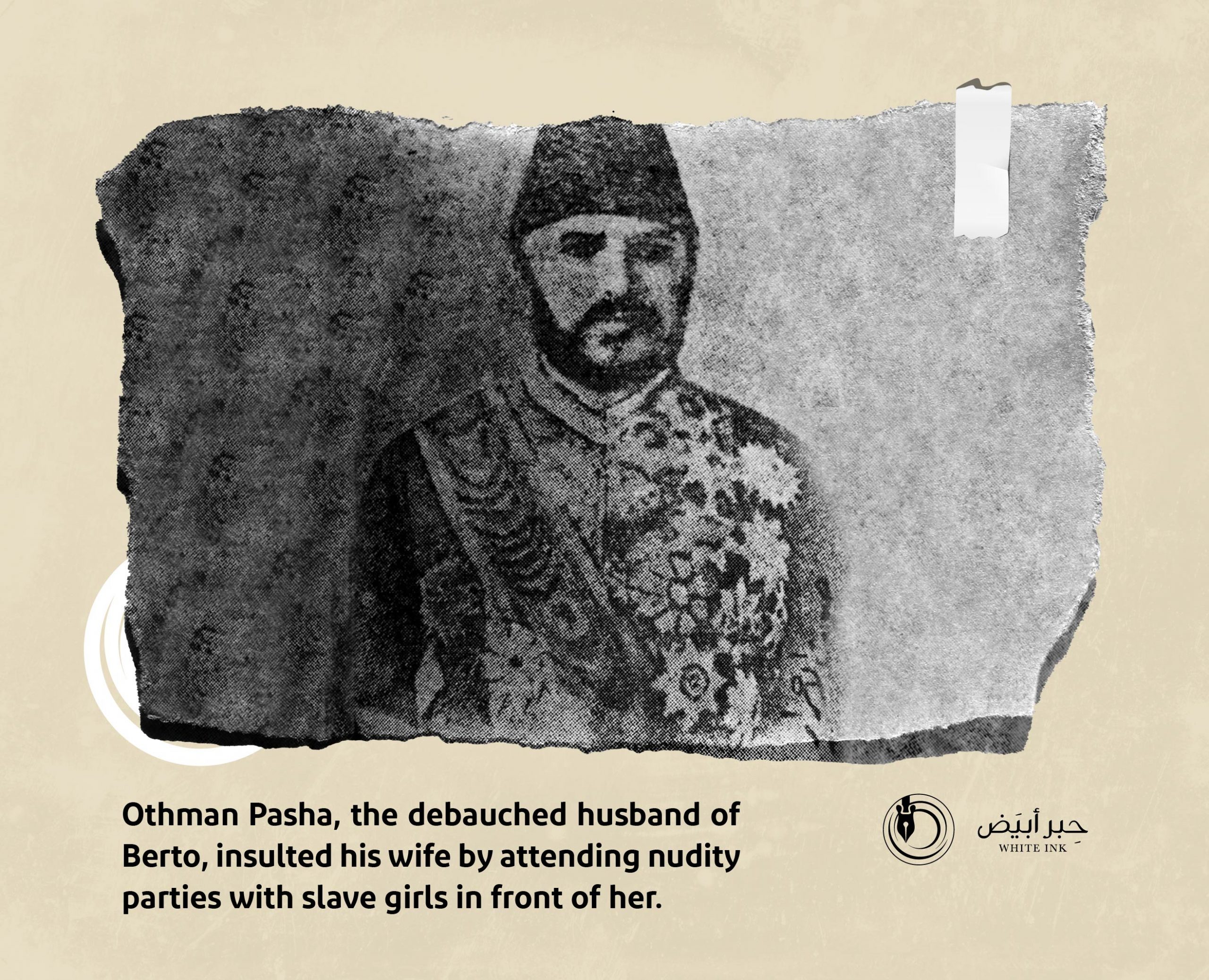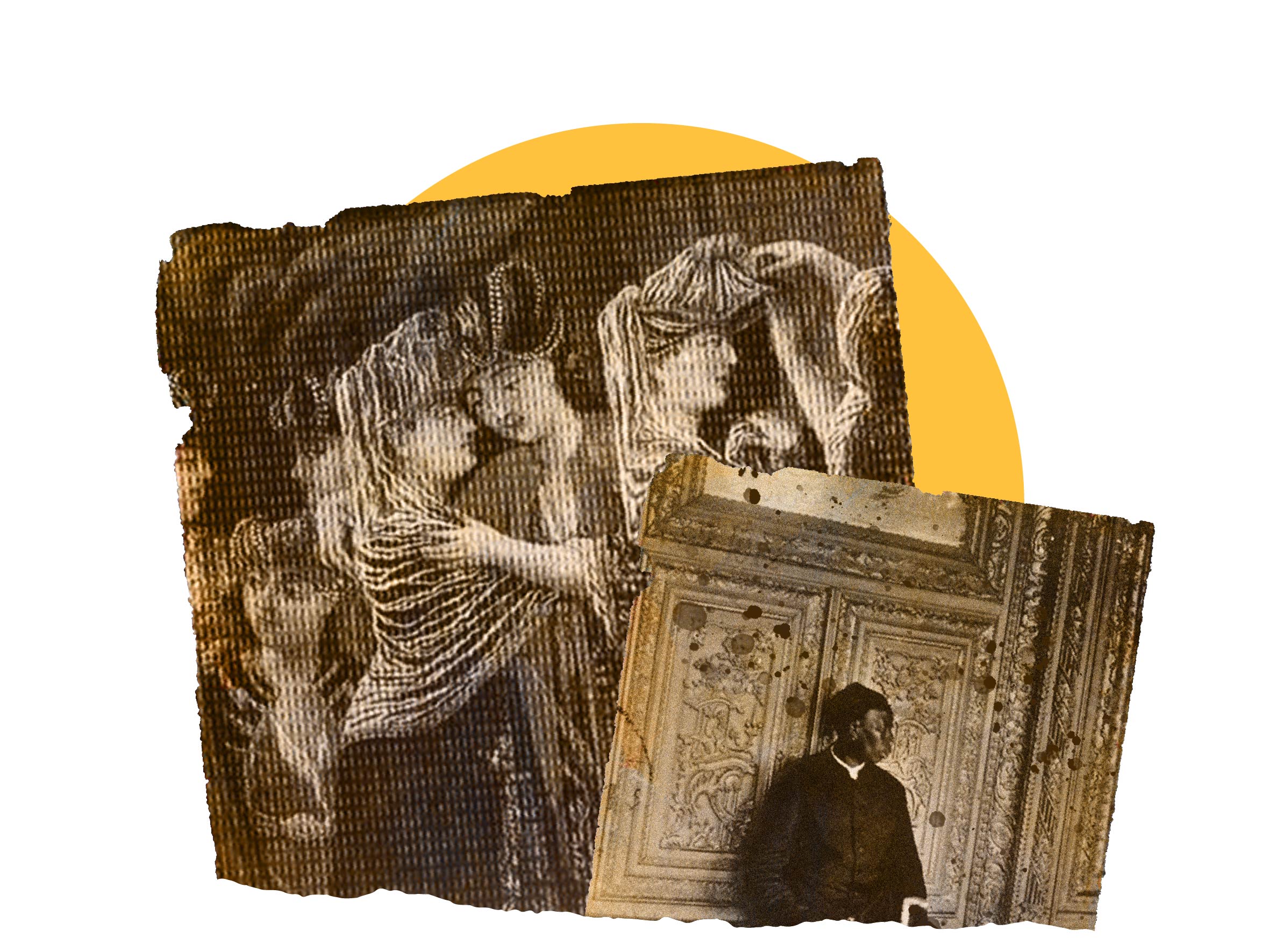
Systematic torture at the luxurious Ottoman palaces parties
What secrets did the chief of the aghas in the era of Abdul Hamid II reveal in his diary?
Before the era of writing down, the stories were memorized orally, and the narrators told them orally, so that they reached the researcher. This simple mechanism is what brought all the books of Arab and international heritage to us. This process is also what proves that there is no force on earth that can prevent the truth from being spread.
Tyrants ignored this fact and worked on imposing secrecy, for fear that their secrets would be revealed. They imprisoned all those who were tempted to speak, just like the sultans of the Ottoman Empire, who, out of their insistence on imposing secrecy and fear of scandal, were not satisfied with imprisoning those who decided to speak, but rather killed them immediately. Because the Turkish sultans did nothing in their lives except to have fun and sit in the Haremlik where the concubines and the wives of the Turkish sultans were located, they killed everyone who tried to approach this mysterious part of the ruling palaces.
For this reason, the diary of Khairuddin Agha, the chief of the aghas during the reign of Sultan Abdul Hamid II (1876-1909) is among the most important books that revealed what was going on in the Haremlik in detail, and a true panorama of the behavior of the Ottomans. It was called “The Secrets of the Haremlik in the Ottoman Court”, and was issued after the defeat of the Ottoman Empire in the First World War (1914-1918).
Khairuddin Agha added another value through his diary. Which included most of the historical sources that were able to reveal some of what was going on inside the palaces of the Ottoman Empire, that ruled the Islamic world for about 5 centuries and caused ignorance and backwardness after it was at the forefront of nations, relied on quick observations and historians who were close to the events and documents that were revealed.
As for Khairuddin Agha’s diary, it represents the tongue of the victims who lived under enslavement and saw with their own eyes how things were managed in the Ottoman Empire. We can add that no one of the Turkish sultans expected that one of the aghas would one day reveal everything, which doubles the importance of this diary.
From the first page of the book “The Secrets of the Haremlik in the Ottoman Court”, Khairuddin Agha accompanies us to see things the way he saw them with the eyes of a young child whose misfortune led him to serve in the palaces of the Ottomans during the reign of Sultan Abdul Aziz I (1830-1876). After he was exposed to the most heinous human crimes forbidden by the Islamic religion, which is castration, the young child who was dazzled by the decorations of palaces and the lavish gifts that spread in every corner, began to receive instructions that must be followed by all those who worked inside the Haremlik.
These instructions are strict and may cause the death of those who violate them. This is how Khairuddin Agha expressed those instructions. He remembered how he was firstly submitted to the supervisor of the Haremlik, who informed him of the first rule of work in the Haremlik, which is to be deaf, dumb and blind. In the Haremlik, he should not hear anything, and if he hears, he should not speak. He also shouldn’t see anything or he would be subject to severe flogging.
In the system of slavery established by the Turkish sultans who mastered in setting its rules until it became the worst system of slavery throughout history, flogging was not the fate of disclosing secrets, but rather a person can be flogged because of a simple question, even if it is normal. One of the rules of slavery imposed by the Ottomans on the aghas was that they had no right to ask about the simplest things.
Khairuddin Agha says he was flogged for daring to ask a question. He also mentioned how some eunuchs were subjected to severe flogging punishments because of simple questions, such as inquiring about how to reach a place they did not know because of their recent presence in the Ottoman palaces, but even that was not a justification for them to be pardoned. After the death of more than one Agha from his wounds due to flogging, Khairuddin Agha described the matter by saying that what was happening was systematic torture in absence of protection.
Slaves were subjected to torture and murder without guilt.

If one of the eunuchs complains to the police about the mistreatment of his chief, the police do not take his words to account because he is an incompetent slave, and therefore this slave is arrested and imprisoned on charges of defaming the Ottoman court.
As one of those who lived in this enslavement system, Khairuddin Agha revealed that the aghas remained imprisoned in the Ottoman palaces and few were allowed to go out. Usually those who were allowed were those who held positions in the aghas system established by the Ottoman sultans. Because of this long imprisonment, relations arose between a number of the aghas and some of the concubines and wives of the Ottoman sultans, and some of the aghas were even jealous over these women. The Ottoman history is filled with many alliances between the aghas and the women of the Haremlik, even love stories that affected the Ottoman palace itself.
In addition to the system of slavery to which the aghas were subjected, in the beginnings of his book “The Secrets of the Haremlik in the Ottoman Court”, Khairuddin Agha guides us to another aspect that the Turkish sultans kept concealing, which is the aspect of extravagance and wasting at the time when Muslims suffered from poverty and hunger.
Perhaps the greatest example of this extravagance is the money of Muslims that was spent on the royal parties in the Ottoman court. Khairuddin Agha reveals that any royal party was preceded by great preparations for several days and perhaps weeks in order to prepare the celebration clothes and the huge money spent in this way. These parties turned into a reason for the women of the palace to be jealous of each other, as each one was plotting to find out what her rival would wear at the royal party so that she would wear the same or better than her so that none of them would be the only one who gets the admiration of the Sultan.
The parties held by the sultans were a reflection of extravagance and promiscuity.

This rivalry, which some may think trivial, is in fact important. The Sultan’s admiration for a concubine means giving her a special place, according to the protocols of the Ottoman palaces. That concubine could become the wife of the sultan and the mother of his children, who would later take the throne, and it happened a lot.
Khairuddin Agha’s book reveals the details of these royal parties, which were subject to many regulations, starting with the selection of luxurious, bright and expensive clothes, and how was the preparation of non-Muslim musicians and dancers according to Ottoman protocols. All this in addition to the orders of the Ottoman Sultan related to the invitation of party guests, and the opening and ending dates of the party. Those parties were repeated periodically despite their high cost.
Khairuddin Agha shows us the secret world of the Sultan’s Haremlik to reveal the truth about those who claimed to rule in the name of Islam, and it turned out that they were nothing but men who chased after women and spent their nights among the maidservants who affected the minds of the Ottomans. One of the most obvious examples of this is Othman Pasha, who left his wife on the wedding night to spend the night among the maidservants and ordered them to dance naked around him while he was in a strange state of ecstasy, which angered his wife. This behavior was not unusual for the Turkish sultans. They were the first to create bathing parties in which the naked maidservants dance around the sultan in a large basin. This abnormal behavior is only an example of a system of abnormal behaviors with which the sultans of the Ottoman Empire were known.
The Ottoman sultans left their wives and spent most of their time among the maidservants.



- The diary of Khairuddin Agha (the chief of the aghas during the reign of Sultan Abdul Hamid II), The Secrets of the Haremlik in the Ottoman Court (Beirut: Al-Saeh Library, 2016).
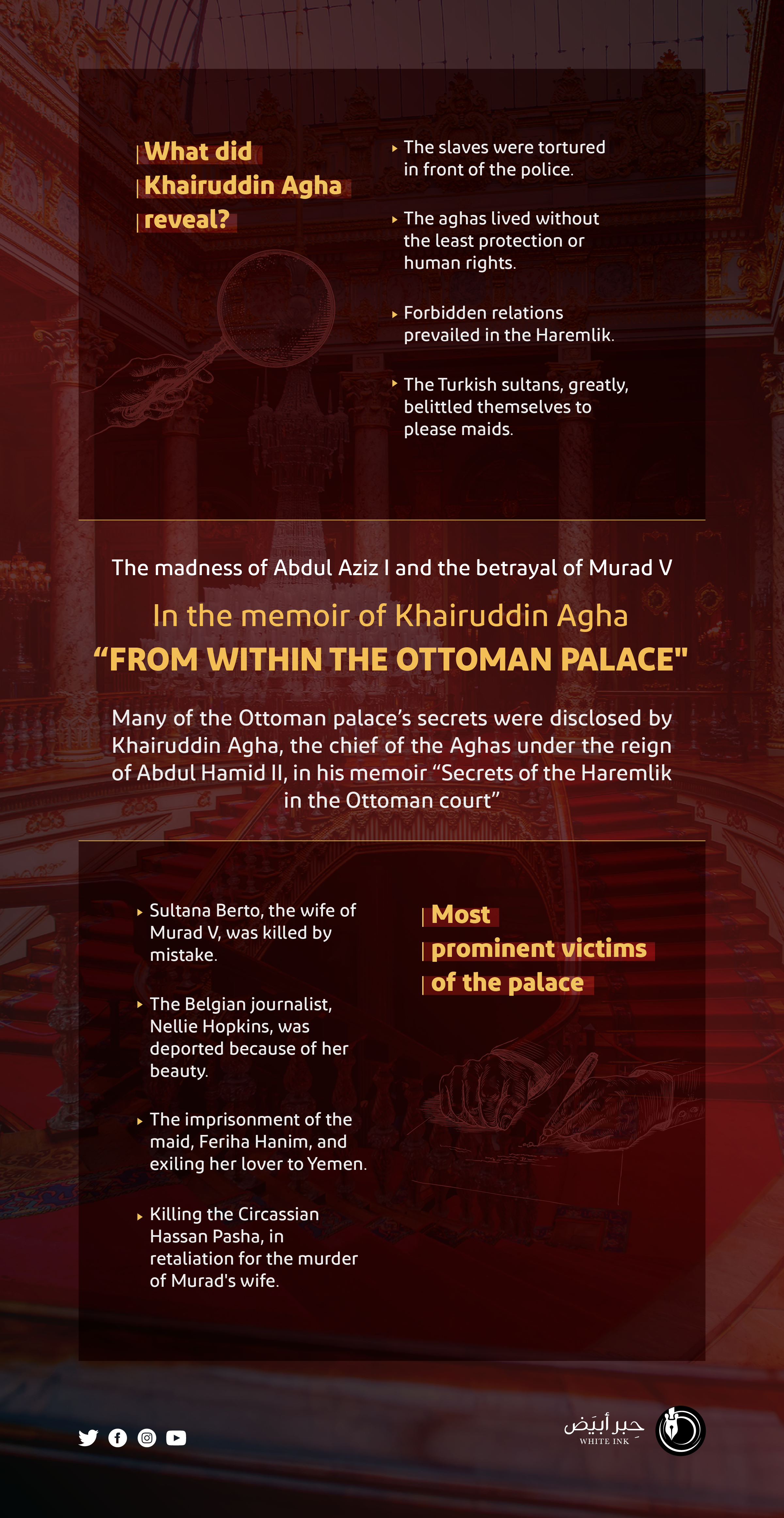
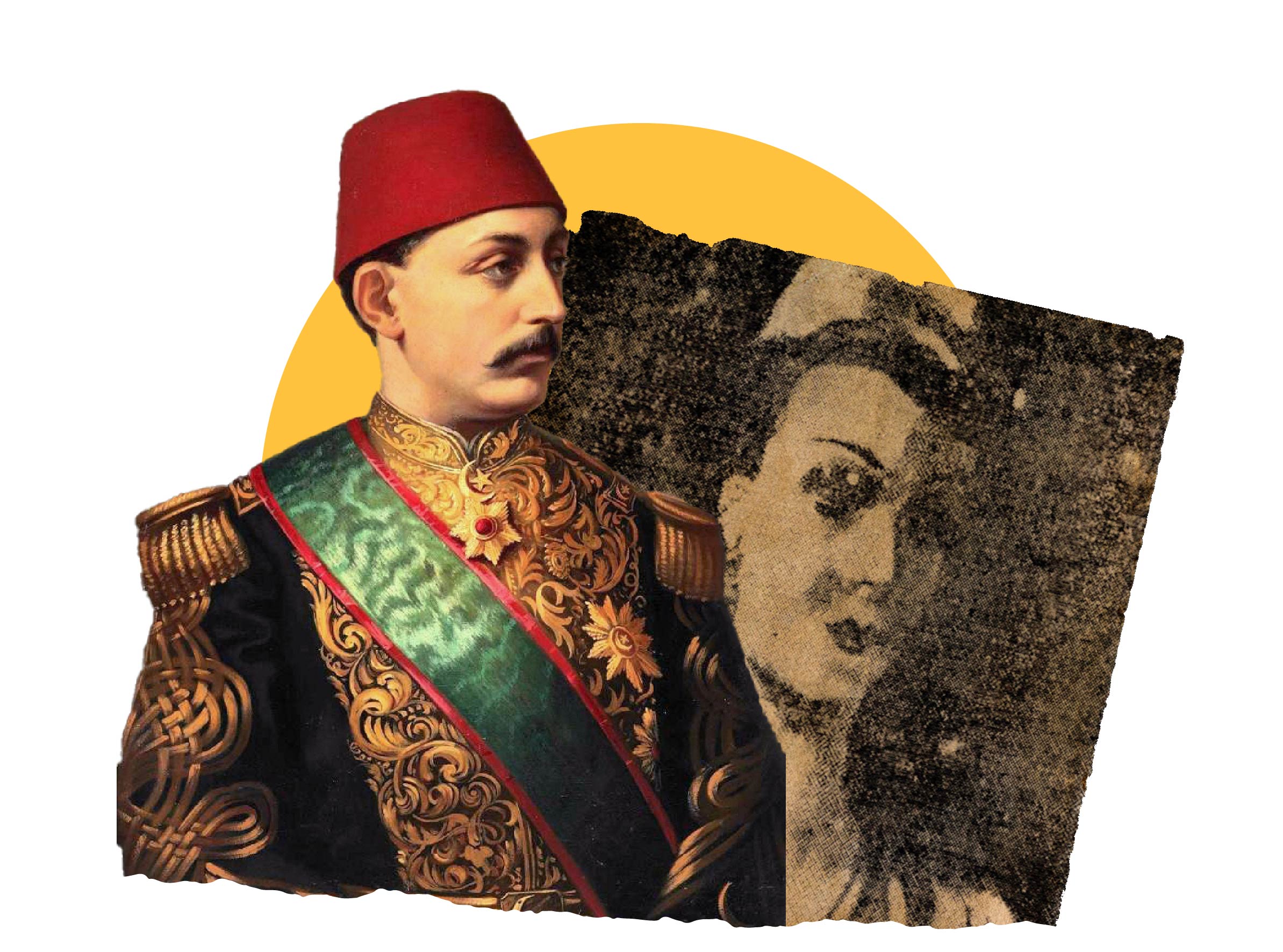
In the memoirs of the chief of the Aghas: Murad V's wife used her lover for rehabilitation
Vengeance within the Ottoman Palace
Historians were not mistaken when they considered the memoirs of Khairuddin Agha, the chief of the Aghas during the reign of the Ottoman Sultan Abdul Hamid II (1876-1909), as a valuable treasure and a decisive historical document.
The memoirs not only revealed what was hidden from those who tried to unravel the mystery of the Ottoman palaces, which were shrouded in secrecy and ambiguity by the Turkish sultans; they even killed everyone who tried to know anything, but also monitored what was behind the locked doors, such as love stories between the Turkish sultans and some of the maidservants, it even revealed that one of the stories almost got Sultan Murad V killed, a situation that trembled the entire Ottoman house.
Khairuddin Agha narrates the story from the beginning, so he says that the conspiracy began during the reign of Sultan Abdul Aziz I, who ruled from 1830 to 1876, and his son was Prince Murad, who would later become Sultan Murad V.
As for the details of that conspiracy, it goes back to the fact that Prince Murad was fond of women and western dancing, which was the reason he used to frequently hit one of the night-clubs at that time, known as the “Orian Club”, where he met a Belgian woman called Nellie Hopkins, an employee at the Belgian embassy who work in the profession of Journalism, and she was beautiful and attractive.
Who is that “Belgian girl” who made Murad V abandon his wife?!

As goes the habit of the Ottoman family, the prince panted after the woman for her he fell, this matter went public, so tongues were gossiping about it, and people talked about the new relationship between the Ottoman prince and the foreign girl, which eventually reached “Berto Sultan”, Prince Murad’s wife at that time.
The wife was not better than her husband, and as the Arabic proverb says, “Birds of a feather flock together.” At first, Berto Sultan submitted a petition to Sultan Abdul Aziz to subdue his son, but he did not consider this petition, especially since Sultan Abdul Aziz I did not love his son, Prince Murad, but – as Khairuddin Agha narrates – he wanted to humiliate his son in order to prevent him from ascending the throne.
This refusal by Sultan Abdul Aziz, prompted Berto Sultan, to seek the assistance of her old lover, Hasan Al- Jirksy, the prominent officer of the Ottoman Guard, and this man loved Berto Sultan before her marriage to Prince Murad, but she refused him.
Berto Sultan’s idea to get rid of her husband’s mistress was for Hasan Al-Jirksi to make that girl fall in love with him so that she deserts Prince Murad. She already summoned one of the Aghas and asked him to invite Hasan Bey, even though intermingling of strangers with the women of the palace was prohibited and whoever violates the laws shall be put to death.
But Berto Sultan did not care and started pulling the strings behind the Ottoman Sultan Abdul Aziz, and her husband, Prince Murad, where she already met him in the middle of the night, using the cheapest women’s tricks to convince him, so she flirted with him and promised him that whatever he desires shall come true, while realizing that Hasan Jirksi desires no-one but her.
The ball is now in the court of Hasan al-Jirksi, he knows that he is defying the Ottoman Sultan Abdul Aziz, and realizes that Prince Murad’s wife is coveted by him, but he ignored all that for the sake of the ultimate prize to win Berto Sultan. Such actions, delivers an image of what kind of men the Ottomans were counting on in running the affairs of ruling and army.
Hasan Al-Jirksi began his plan, so he went to the “Orian Club” and was caught by Nelly Hopkins’s beauty, he was able to make her fall in love with him until she left the grand palace with him, which Prince Murad had prepared for her.
Prince Murad went mad when he knew that the girl had abandoned him. He could not spend a day without picturing her, neglecting all the governance issues, he even sent his spies to find out the truth behind this desertion until he found out that she lives with Hasan Bey al-Jirksi; at this moment, Prince Murad found himself in great confusion, because he realizes the great position that Hasan al-Jirksi reached with his father, Sultan Abdul-Aziz, and even when the latter knew about the matter, he was pleased afterwards, that this love story of Prince Murad and the foreign girl was closed as it started affecting the reputation of the Ottoman family, so Sultan Abdul Aziz did nothing but granting the title of Pasha to Hasan al-Jirksi, as a sign of his satisfaction and joy with what he did.
Prince Murad never gave in to that outcome. As for the palace, it is only preoccupied by the story of the prince and the mistress; Maidservants are talking, and the Ottoman Sultan Abdul Aziz is busy monitoring his son, and Prince Murad is looking for revenge, but the parish, important decisions and people’s lives are nothing to these sordid desires.
Prince Murad’s first move came by summoning three of those who were close to him and assigned them to take revenge on Hasan al-Jirksi, who became Pasha. As for al-Jirksi himself, he tried to contact Berto Sultan again, in order to submit herself to him as she promised, but she tossed him out and told him through a delegate that he had taken the reward by granting him the title of Pasha and would not give him more than that.
When Hasan al-Jirksi received this response, he threatened Berto Sultan to reveal everything if she did not accept to meet with him, and he would return the Belgian girl to her husband; the one who carried the messages between them was Abram Agha, and Berto Sultan did not find any escape from this meeting and informed Hasan Pasha to prepare for their meeting without anybody noticing.
As night raiders, Berto Sultan hid, to meet her lover in his house, which coincided with the movement of the three men who were ordered by Prince Murad to take revenge on Hasan al-Jirksi and his mistress.
Hasan Pasha was preparing to spend the night of his life; he prepared everything and dismissed the servants. At the same time, Prince Murad’s spies were waiting for the arrival of the Belgian girl, Nellie Hopkins, to pounce on her. When Sultana Berto Sultan’s cart, driven by Abram Agha, arrived, the spies witnessed a closed cart with a woman, they thought it was the Belgian girl, so they jumped on Abram Agha and killed him and they wounded Berto Sultan deeply, then tried to drag the cart, but they were down on their luck when one of the horses fell, and the cart stopped moving, and Berto Sultan screamed, so the spies felt they were compromised and feared that Hasan Pasha would raid them with his servants; thus, they tried to escape.
The sultan’s spies who killed his wife instead of his mistress.

As for Hasan Pasha, when he heard this scream, he rushed only to be surprised by the scene of men attacking his beloved where he tried to chase them, but they escaped; he was preoccupied with Berto Sultan thereafter, who was found unconscious, so he carried her on the cart and took her to the clinic of Dr.Hasan Awni, one of the doctors of the Royal Palace, and came up with this pretension that a group of criminals had attacked one of the princesses of the royal house, and he happened to pass by, so he ran to rescue her, but she was dying.
But the doctor, Hasan Awni, as soon as he laid his eyes on her, knew that she is the wife of Prince Murad, so he was surprised and tried to save her, but it was pointless. With her dying breath, she rose up and said, “Hasan Pasha, why did you kill me?”. She was referring to Al-Jirksi, whom she thought had sent these men to her, in retaliation for not fulfilling her part of the deal.
The doctor, Hasan Awni, heard those only words before Berto Sultan death. As for Hasan Al-Jirksi, when he saw that his beloved has passed away, he could not speak a word, and after attempts to push him to talk, he said: I did not mean the princess, but her husband, and I thought he was in the cart, so I attacked her; he chose not to tarnish her reputation in exchange for framing himself for this charge, a charge that is punishable by hanging.
Hasan Al-Jirksi added that he wanted to kill Prince Murad because he deprived him of his beloved and he was referring to the Belgian girl, Nelly Hopkins, to be detained thereafter; the Ottoman Sultan Abdul Aziz came running to find out about this conspiracy that threatened the pillars of Ottoman rule, to such an extent of attempting to assassinate an Ottoman prince who, after a few years, would become Sultan and ruler of the country, Hasan al-Jirksi confessed to Sultan Abdul Aziz that he tried to kill Murad because of the Belgian girl, but he was not plotting against the Ottoman family.
With such scandal, the Ottoman Sultan Abdul Aziz ordered to conceal everything that had happened and summoned Ismail Shawqi Pasha, one of his leaders, and ordered him to get rid of Hasan Pasha and he carried out this order and killed the man. As for the Belgian girl, Nelly Hopkins, she was deported outside the country on the orders of the Sultan.
Hasan al-Jirksi was murdered before eliminating Murad V



- Memoirs of Khairuddin Agha (the chief of the Aghas during the reign of Sultan Abdul Hamid II), Secrets of the Harem in the Ottoman court (Beirut: Al-Saeh bookstore, 2016).
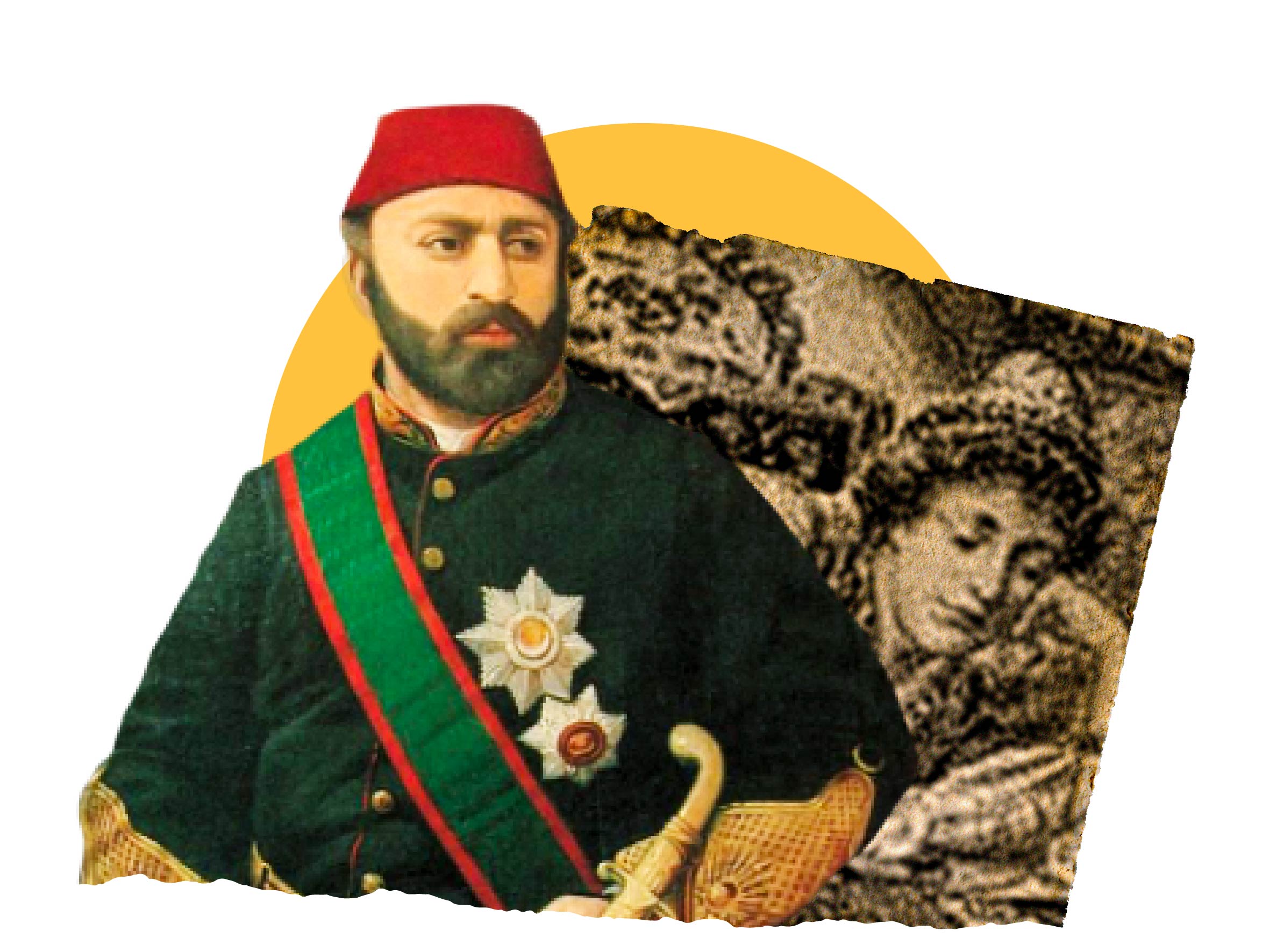
Khairuddin Agha: Sultan exiled his wife’s lover
Feriha Khanum...
a maidservant who stole Sultan Abdul Aziz's heart away
It is the story of injustice repeated at any time and in any place whatsoever. An innocent girl, blessed with beauty from God, dreams of a bright future and a pure heart, and a white knight to kidnap her. Suddenly, everything turns into a nightmare, she finds herself in the hands of a tyrant who cares about nothing but devouring her flesh and putting her in a cage so that nobody can lay an eye on her but him. At that moment, her beauty turned into a curse, and history narrates a new story of the injustice of the tyrants.
Since the emergence of the Ottoman sultans and domination of the country and people, history has not stopped writing stories of injustice that filled volumes, and their enslavement of people, which became an example of immorality of the Ottoman family.
In chapter II, in the memoirs of Khairuddin Agha, the chief of the Aghas in the era of Sultan Abdul Hamid II (1876-1909), Khairuddin Agha narrates a new story of injustice; the main character of which was Sultan Abdul Aziz I (1830-1876).
Abdul Aziz I was not different from his ancestors; as Suleiman the Magnificent fell in love with “Roxlana” until he neglects the armies and sat next to her writing poetry, this happened again with Sultan Abdul Aziz I, who was fascinated by the maidservant Feriha Khanum, who had an emotional relationship with Hasan Bey before Abdul Aziz I stepped in and exile this lover to Yemen to be alone with his beloved.
There is no love without freedom, a rule that was ignored by the Turkish sultans; that beautiful girl who fell in love and dreamed of having a small house and a family, suddenly found herself inside the sultan’s palace after her lover left her forcibly, all colors are in blues; a prison, no matter how wide, one still feels so squeezed; according to the enslaving Ottoman protocols, Feriha Khanum became a property of Abdul Aziz I, who, despite all his influence and authority, knew from within that she had no love for him, and like any oppressor who realizes that he has no control over hearts, his love turned into insane jealousy and constant skepticism, as if he says if she is not mine, then she is not for anyone else.
Khairuddin Agha introduces us to the details of that relationship, in which he was one of the parties thereafter, and says that at his early time in the Ottoman palaces he was carrying a message to Feriha Khanum; suddenly he saw a prestigious man shouting loudly, “Where is the man”, and Feriha confirms that there is no man, The man then directed his question to Khairuddin, warning him from lying, and insisting that there was a strange man who was hidden; Khairuddin told him that he had not seen any man, and he was just a messenger carrying a message to Feriha Khanum.
At this moment, Khairuddin realized that he was in front of Sultan Abdul Aziz in person; as he never had the opportunity to see him before, and Khairuddin knew that Sultan Abdul Aziz was jealous, He did not accept that Feriha Khanum had a former lover. His jealousy led him to imagine that she was having her former lover in her royal chamber!
Sultan Abdul Aziz did not rest until he sent a message to the Ottoman governor in Yemen to make sure that his rival was still in Yemen, as Sultan Abdul Aziz had sent the man away to Yemen so that Feriha Khanum would forget him.
Abdulaziz was under hallucinations, and imagined men with his beloved.

This cinematic scene was not the only one that summarizes the story of Abdul Aziz I with Feriha Khanum. Khairuddin Agha reveals in his memoirs “the Secrets of the Haremlik in the Ottoman Court”, that after the former incident, Abdul Aziz I wanted to appease Feriha Khanum, so he held her an exorbitant royal party, that drained the resources of Muslims. Many public figures were invited to the party; in Khairuddin Agha’s words, the goal of the party was not only to appease Feriha Khanum, but to “force all the women of the palace to pay their respect to her.
Like the tales of One Thousand and One Nights, in the same party, another surprising incident occurred, the hero of which is suspicion. The eye of Sultan Abdul Aziz I, who does always watch out for Feriha Khanum, noticed during the party, hundreds of dancers and guests that “Feriha Khanum” did not wear her medal, which was always hanging on her neck day and night. Suddenly, blood started to boil in the veins; the sultan rose up like a madman babbling silently that his beloved had given that present to Hasan Bey who was in exile at this time!
Situation escalated further, and the Ottoman palace was turned upside down, as he left the affairs of the parish, governance, armies, and securing the country. The most important thing is to find the medal so that the Sultan calms down, and not to feel that someone has slapped him, and here comes the role of Khairuddin Agha, who has a strong relationship with Feriha Khanum, who found him a good Agha; during the search process that was assigned to all the workers in the palace, Khairuddin Agha found the medal, but inside it was a picture of Hasan Bey, her former lover. This is how love survive despite the oppression of the Turkish sultans.
Feriha Khanum kept her lover's picture despite the Sultan's love for her.

The crisis heated up, and the Sultan’s suspicions that someone had slapped him was confirmed; at this moment, Feriha Khanum stepped in and made a deal with Khairuddin Agha by replacing the medal with one that does not have a picture of Hasan Bey, which is what happened and the medal was arranged to be found again by a coincidence in front of the palace workers.
The plan executed by Khairuddin Agha succeeded and Sultan Abdul Aziz I fell for it; he even apologized to Feriha Khanum and tried to appease her in every possible way and promised her to hit all her enemies mercilessly, asking her to decide the punishment she wants.
What was revealed in the memoirs by Khairuddin Agha is nothing but a live model inside the Ottoman palaces; a sultan is insanely suspicious, a maidservant who does not love her sultan and conspires to save herself after she was deprived of her lover and imprisoned in the palaces of the Ottoman family, conspiracies carried out by the Aghas; this lifestyle has been repeated a lot with different names and details, but there is no doubt that hatred prevailed in the palaces of the Ottoman family and deception was the lifestyle of those in the palace, as for the subjects, they were out of the equation.
Feriha Khanum allied with Khairuddin Agha to deceive Sultan Abdul Aziz.



- Memoirs of Khairuddin Agha (the chief of the Aghas during the reign of Sultan Abdul Hamid II), Secrets of the Haremlik in the Ottoman court (Beirut: Al-Saeh bookstore, 2016).


